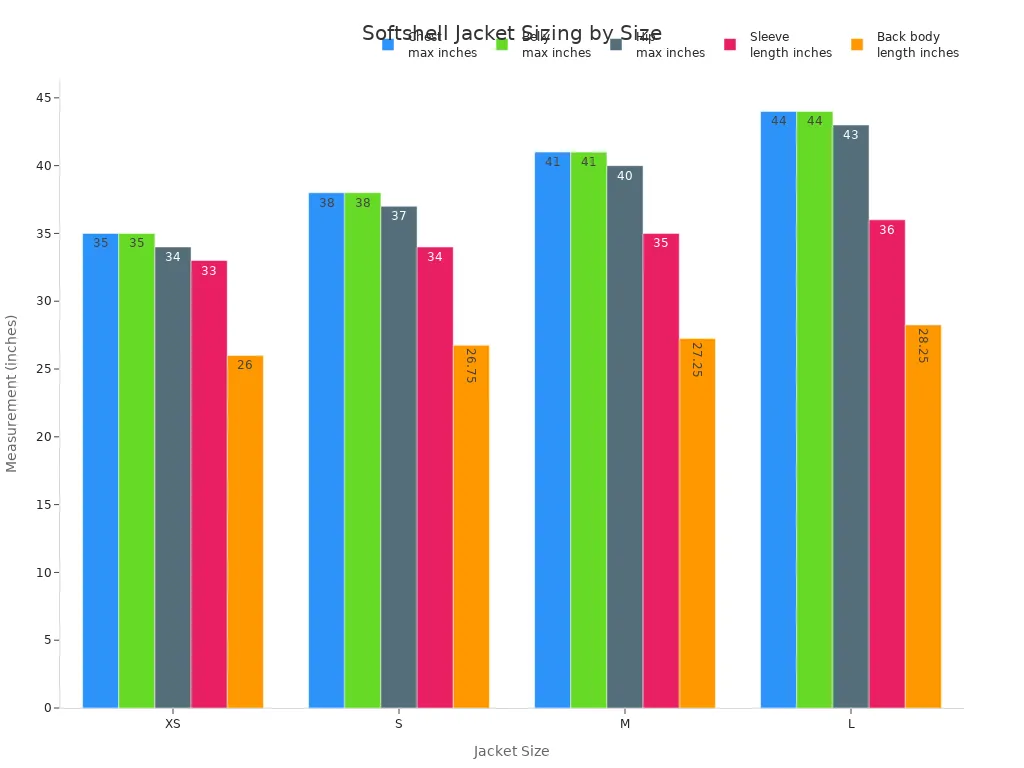Softshell Jacket Comfort You Can Count On

You want a jacket that feels good in any situation. A softshell jacket gives you comfort thanks to its stretchy fabric and flexible design. You can move freely during outdoor activities or daily tasks. Breathable materials help heat and moisture escape, so you stay dry and cool. Light water and wind resistance keep you protected from sudden changes in weather. Are softshell jackets comfortable? Absolutely—they combine flexibility, breathability, and just the right amount of protection to make you feel at ease wherever you go.
Key Takeaways
Softshell jackets offer great comfort with stretchy, breathable fabrics that let heat and moisture escape, keeping you dry and cool during activities.
These jackets provide flexible fits with features like adjustable cuffs and articulated sleeves, allowing free movement without feeling tight or bulky.
Softshells protect against wind and light rain but are not fully waterproof, making them ideal for mild weather and active use rather than heavy rain.
Choosing a softshell made with sustainable materials helps reduce environmental impact while still delivering durability and comfort.
Proper sizing and care, like gentle washing and waterproofing treatments, keep your softshell jacket comfortable and long-lasting for many adventures.
Softshell Jacket Features

Breathable Materials
You stay comfortable in a softshell jacket because of its advanced breathable materials. These fabrics let heat and moisture escape, so you avoid overheating during activities like hiking or running. Most softshell jackets use technical fabrics such as polyester blends, nylon, and sometimes spandex or elastane. These materials stretch and move with you, while also managing moisture. Many jackets feature a double-layer system: a tough outer shell for durability and a soft inner lining for warmth and comfort. Some models add a thin insulating layer, which helps regulate your body temperature in cooler weather.
Tip: Look for jackets with a durable water repellent (DWR) finish. This treatment helps shed light rain while keeping the fabric breathable.
Laboratory tests measure breathability using two main methods: RET (Resistance of Evaporation of a Textile) and MVTR (Moisture Vapor Transmission Rate). Lower RET values and higher MVTR numbers mean better breathability. For example, a RET value between 0-6 is considered extremely breathable. These tests show that softshell jackets often outperform hardshells in breathability, making them ideal for active use.
Metric | What It Measures | Best Value for Comfort |
|---|---|---|
RET | Resistance to moisture vapor | 0-6 (very breathable) |
MVTR | Water vapor passing through fabric | >20,000 g/m²/day |
Flexible Fit
You need a jacket that moves with you. Softshell jackets use stretchy woven fabrics, such as nylon or polyester with added spandex or elastane. This stretchiness gives you a flexible fit, whether you are climbing, biking, or just reaching for something on a shelf. Articulated sleeves and tailored designs help the jacket follow your movements, so you never feel restricted. Many jackets include features like adjustable cuffs, hoods, and hems, letting you customize the fit for any activity.
Mobility-enhanced stretch sleeves allow free movement.
Articulated fits follow your body’s natural shape.
Soft-touch fleece liners add comfort and flexibility.
High-set pockets and helmet-compatible hoods support outdoor adventures.
User reviews often mention that these jackets feel lightweight and comfortable for both active and everyday wear. Some users recommend sizing up, as the athletic fit can run small. When you find the right size, you get a jacket that feels just right—never too tight or too loose.
Weather Resistance
A softshell jacket protects you from wind and light rain without sacrificing comfort. The outer fabric is usually a tough polyester or nylon, sometimes bonded to a water-resistant film. Many jackets have a microfleece lining for extra warmth. Water-resistant coatings, such as DWR, help rain bead up and roll off the surface. Wind-blocking flaps behind zippers and adjustable hoods add extra protection.
Soft polyester exterior with waterproof lining keeps weather out.
Bonded microfleece interior adds warmth.
Water-resistant zippers and wind-blocking flaps improve performance.
Seams are sewn, not taped, so jackets resist but do not fully block heavy rain.
Softshell jackets do not use fully waterproof membranes like hardshells. This means you get better breathability and flexibility, but you should choose a hardshell for heavy rain or snow. For most outdoor activities, a softshell jacket offers the right balance of protection and comfort.
Sustainable Design
You can make a positive impact by choosing a softshell jacket with sustainable features. Many brands now use recycled polyester (RPET), which reduces the need for new plastic and cuts down on waste. Some jackets use PFAS-free waterproofing treatments, avoiding harmful chemicals found in traditional coatings. Durable construction and repair programs help extend the life of your jacket, reducing its environmental footprint.
Recycled polyester lowers dependence on new oil and plastic.
PFAS-free treatments reduce toxic chemical use.
Durable designs and repair options keep jackets in use longer.
Traditional jackets often rely on virgin polyester and energy-intensive production, which increases their environmental impact. By choosing a sustainably designed softshell jacket, you help protect the planet while staying comfortable outdoors.
Comfort Comparison
Softshell Jacket vs. Hardshell
You might wonder how a softshell jacket compares to a hardshell when it comes to comfort. The main differences come down to breathability, flexibility, and protection. Softshell jackets use woven polyester or nylon, which makes them flexible and breathable. You can move easily and stay cool during high-intensity activities. Hardshell jackets, made from rigid materials like PU or PTFE, focus on blocking wind and water. They protect you in harsh weather but often feel stiff and less breathable.
Softshell jackets rate higher for comfort in user surveys, especially during active use.
You get better air circulation and moisture control with a softshell, which helps in dry, cold, or warm conditions.
Hardshells excel in wind and water protection but can trap heat and sweat, making them less comfortable for exercise.
Some high-end hardshells add vents or breathable membranes, but most still lag behind softshells in comfort.
Your choice depends on your activity and the weather. For dry, active days, a softshell jacket keeps you comfortable. For heavy rain or snow, a hardshell offers better protection.
Note: Experts agree that softshell jackets outperform hardshells in breathability and flexibility, making them a top pick for comfort during movement.
Feature | Softshell Jacket | Hardshell Jacket |
|---|---|---|
Breathability | High | Low to Moderate |
Flexibility | Excellent | Limited |
Weatherproofing | Light rain, wind | Heavy rain, snow, wind |
Comfort Rating | High (active use) | Moderate (static use) |
Softshell vs. Fleece
You may also compare a softshell jacket to a fleece. Fleece jackets feel soft and warm, but they lack weather resistance. Softshells combine a stretchy, breathable shell with a fleece lining. This design gives you warmth without bulk and adds protection from wind and light rain.
Softshells breathe well, so you avoid sweating during activity.
They stretch to fit your body, letting you move freely.
You stay dry and comfortable because moisture escapes easily.
Softshells resist wind and water better than fleece.
Fleece jackets work best as mid-layers. They insulate but do not block wind or rain.
Many athletes prefer softshells for outdoor sports because they avoid the clammy feeling that comes with less breathable jackets.
Tip: Use a fleece under a softshell for extra warmth in cold weather. This layering strategy gives you insulation and moisture control.
Feature | Softshell Jacket | Fleece Jacket |
|---|---|---|
Breathability | High | Moderate |
Flexibility | Excellent | Good |
Weatherproofing | Light rain, wind | None |
Insulation | Moderate (with lining) | High |
Comfort Rating | High (active use) | High (static use) |
Choosing Comfort
Key Features
When you look for a softshell jacket, focus on features that boost comfort and performance.
Breathability keeps you dry by letting sweat escape.
Flexibility comes from stretchy fabrics like polyester or nylon with elastane, so you move freely.
Comfort improves with a soft inner lining, often fleece or brushed polyester.
Water resistance protects you from light rain and snow.
Lightweight and packable designs make travel and storage easy.
Insulation adds warmth for cooler days.
Wind resistance shields you from cold gusts.
Durability ensures your jacket lasts through many adventures.
Adjustable cuffs and hoods let you seal out cold air and customize your fit. These features help you stay warm and block wind or rain, especially during changing weather.
Sizing Tips
Proper sizing matters for comfort and performance. A jacket that fits well moves with your body and avoids discomfort. Use this table to compare common size measurements:
Size | Chest (max, inches) | Belly (max, inches) | Hip (max, inches) | Sleeve Length (inches) | Back Body Length (inches) | Height Range (feet) |
|---|---|---|---|---|---|---|
XS | 35 | 35 | 34 | 33 | 26 | 5’1″ – 5’8″ |
S | 38 | 38 | 37 | 34 | 26.75 | 5’3″ – 5’10” |
M | 41 | 41 | 40 | 35 | 27.25 | 5’7″ – 6’1″ |
L | 44 | 44 | 43 | 36 | 28.25 | 5’10” – 6’4″ |

Try on jackets with the layers you plan to wear. If you want a close fit, pick your true size. For layering, choose a size up. Avoid jackets that feel tight or restrict movement. A poor fit can cause discomfort, limit mobility, or even let in cold air.
Activity Match
A softshell jacket works best for active outdoor pursuits. You get the most comfort during activities like hiking, mountain biking, cross-country skiing, or urban commuting. The jacket’s breathability and stretch help you stay cool and move easily. Wind and water resistance protect you from sudden weather changes. For high-intensity sports, the jacket’s ventilation keeps sweat from building up. For low-intensity outings, insulation and adjustable features help you stay warm. You can rely on a softshell jacket for comfort in mild or changing weather.
Real-World Comfort

User Experiences
You can count on comfort when you wear a softshell in real life. Many users share stories about staying dry and cool during long hikes, even when the weather changes quickly. Breathable fabrics let sweat escape, so you avoid feeling clammy after hours of activity. People who work outdoors, like in construction or delivery, say these jackets keep them comfortable through wind and light rain. Adjustable cuffs and hems help you get a snug fit, which blocks out cold air and keeps you moving freely.
“I wore my jacket on a chilly morning bike ride. The wind stayed out, but I never overheated. The stretch made it easy to move, and the pockets kept my hands warm,” says one cyclist.
Some jackets include fleece linings or extra insulation. These features help you stay warm in colder climates. Users often mention that for very cold days, you may want to add a base layer underneath. The versatility of these jackets makes them a favorite for both work and play.
Care Tips
Proper care keeps your jacket comfortable and performing well. Follow these steps to make it last:
Wipe off dirt with a damp cloth after each use to avoid frequent washing.
Wash the jacket alone on a gentle cycle at 30°C, using a mild detergent made for technical fabrics. Avoid fabric softeners and bleach.
Turn the jacket inside out and close all zippers before washing.
Skip the spin cycle and let the jacket air dry on a hanger. Avoid high heat.
Check the water repellency by sprinkling water on the surface. If water does not bead up, apply a waterproofing spray.
Store the jacket dry, in a cool and ventilated place. Avoid folding or hanging it for long periods to prevent stretching.
Repair small tears right away to keep the jacket in top shape.
Regular cleaning and careful storage help preserve breathability and water resistance. Always follow the care label for best results.
You can trust these jackets for comfort in changing weather. Features like 4-way stretch fabric, windproof materials, and a brushed thermal interior keep you warm and let you move freely. Many users praise their lightweight feel, adjustable cuffs, and secure pockets.
You stay comfortable during activities from hiking to commuting.
You get reliable protection from wind and light rain.
You enjoy flexibility and warmth without extra bulk.
Have questions or want to share your experience? Leave a comment below!
FAQ
How do you wash a softshell jacket?
Wash your jacket in cold water on a gentle cycle. Use a mild detergent. Avoid fabric softeners and bleach. Close all zippers before washing. Air dry the jacket for best results.
Can you wear a softshell jacket in heavy rain?
You should not wear this jacket in heavy rain. It resists light rain and wind but does not keep you dry in downpours. Choose a waterproof jacket for wet weather.
What activities suit a softshell jacket best?
You can wear this jacket for hiking, biking, running, or commuting. It works well for outdoor sports and daily use. The jacket offers comfort and flexibility during movement.
How do you restore water resistance?
Spray a DWR (durable water repellent) treatment on the clean, dry jacket. Follow the product instructions. This helps water bead up and roll off the fabric.
Is a softshell jacket warm enough for winter?
You can wear this jacket in cool weather. For cold winter days, add layers underneath. The jacket provides moderate warmth but does not replace a heavy winter coat.

